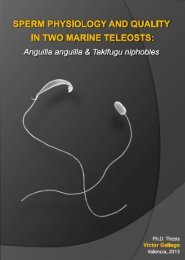TESIS DOCTORAL - RiuNet - Universidad Politécnica de Valencia
TESIS DOCTORAL - RiuNet - Universidad Politécnica de Valencia
TESIS DOCTORAL - RiuNet - Universidad Politécnica de Valencia
Create successful ePaper yourself
Turn your PDF publications into a flip-book with our unique Google optimized e-Paper software.
Chapter 1<br />
obtusisporum. According to Booth, however, 2–3-septate macroconidia of “C.”<br />
obtusisporum measure [34–50×6–7.5 µm]. “Cylindrocarpon” obtusisporum isolates<br />
obtained from California formed perithecia when cross-inoculated with “C.”<br />
macrodidymum, giving further evi<strong>de</strong>nce to support the misi<strong>de</strong>ntification theory. This<br />
was also confirmed by sequence comparisons (Halleen et al., 2006a). In 2005, Petit and<br />
Gubler confirmed the presence of “C.” macrodidymum in the USA, and conclu<strong>de</strong>d that<br />
black-foot disease in California is caused by “C.” macrodidymum and “C.” <strong>de</strong>structans<br />
(Petit and Gubler, 2005).<br />
Moreover, Halleen et al., (2004) established a new genus, Campylocarpon<br />
Halleen, Schroers & Crous, which is “Cylindrocarpon”-like in morphology, associated<br />
with black-foot disease of grapevines. Species of this genus and members of the former<br />
“Nectria” mammoi<strong>de</strong>a group, are exclu<strong>de</strong>d from Neonectria/“Cylindrocarpon”, because<br />
phylogenetic analyses revealed that these species are phylogenetically not closely<br />
related to Neonectria/“Cylindrocarpon” genera (Halleen et al., 2004; Schroers et al.,<br />
2008). From this genus, two species were inclu<strong>de</strong>d as the causal agents of black-foot<br />
disease: Campylocarpon fasciculare Schroers, Halleen & Crous, which has been<br />
reported in South Africa (Halleen et al., 2004), Brazil (Correia et al., 2012), and Spain<br />
(Alaniz et al., 2011b) and Campyl. pseudofasciculare Halleen, Schroers & Crous, which<br />
has been reported in South Africa (Halleen et al., 2004), Uruguay (Abreo et al., 2010),<br />
Brazil (Correia et al., 2012) and Perú (Álvarez et al., 2012).<br />
As highlighted before, “C.” <strong>de</strong>structans was originally i<strong>de</strong>ntified as the causal<br />
agent of black-foot disease (Maluta and Larignon, 1991), but the status of “C.”<br />
<strong>de</strong>structans as the causal agent of the disease has since then questioned. In fact, Halleen<br />
et al. (2006b), compared “C.” <strong>de</strong>structans strains isolated from diseased grapevines in<br />
France, New Zealand, Portugal and South Africa with “C.” <strong>de</strong>structans-like anamorphs<br />
obtained from various herbaceous or woody hosts. DNA analyses of their internal<br />
transcribed spacer (ITS) and partial β-tubulin genes (TUB) showed that these isolates<br />
were genetically i<strong>de</strong>ntical with “C.” lirio<strong>de</strong>ndri J.D. MacDon. & E.E. Butler, which<br />
was first associated with root rot of tulip poplar (Lirio<strong>de</strong>ndron tulipifera L.) in<br />
California by MacDonald and Butler (1981). Thus, because these species had i<strong>de</strong>ntical<br />
sequences, “C.” <strong>de</strong>structans isolates collected from asymptomatic or diseased<br />
grapevines affected by black-foot disease were renamed as “C.” lirio<strong>de</strong>ndri, associating<br />
“C.” <strong>de</strong>structans only with root rot on other herbaceous or woody hosts (Halleen et al.,<br />
12

















